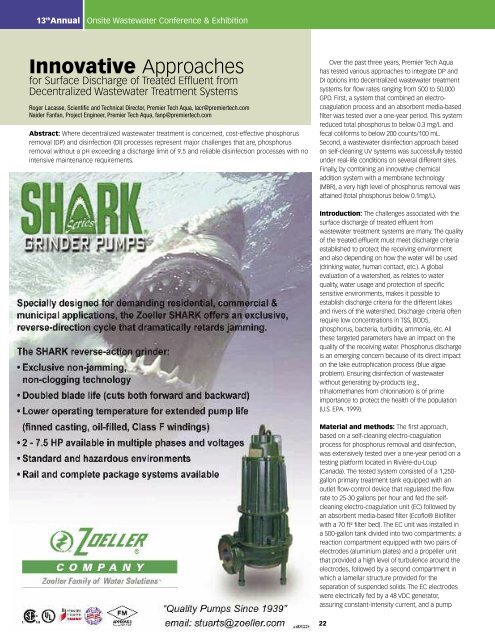Volume 13, Issue 1 - Ontario Onsite Wastewater Association
Volume 13, Issue 1 - Ontario Onsite Wastewater Association
Volume 13, Issue 1 - Ontario Onsite Wastewater Association
Create successful ePaper yourself
Turn your PDF publications into a flip-book with our unique Google optimized e-Paper software.
<strong>13</strong> th Annual <strong>Onsite</strong> <strong>Wastewater</strong> Conference & Exhibition<br />
Innovative Approaches<br />
for Surface Discharge of Treated Effluent from<br />
Decentralized <strong>Wastewater</strong> Treatment Systems<br />
Roger Lacasse, Scientific and Technical Director, Premier Tech Aqua, lacr@premiertech.com<br />
Naider Fanfan, Project Engineer, Premier Tech Aqua, fanp@premiertech.com<br />
Abstract: Where decentralized wastewater treatment is concerned, cost-effective phosphorus<br />
removal (DP) and disinfection (DI) processes represent major challenges that are, phosphorus<br />
removal without a pH exceeding a discharge limit of 9.5 and reliable disinfection processes with no<br />
intensive maintenance requirements.<br />
Over the past three years, Premier Tech Aqua<br />
has tested various approaches to integrate DP and<br />
DI options into decentralized wastewater treatment<br />
systems for flow rates ranging from 500 to 50,000<br />
GPD. First, a system that combined an electrocoagulation<br />
process and an absorbent media-based<br />
filter was tested over a one-year period. This system<br />
reduced total phosphorus to below 0.3 mg/L and<br />
fecal coliforms to below 200 counts/100 mL.<br />
Second, a wastewater disinfection approach based<br />
on self-cleaning UV systems was successfully tested<br />
under real-life conditions on several different sites.<br />
Finally, by combining an innovative chemical<br />
addition system with a membrane technology<br />
(MBR), a very high level of phosphorus removal was<br />
attained (total phosphorus below 0.1mg/L).<br />
Introduction: The challenges associated with the<br />
surface discharge of treated effluent from<br />
wastewater treatment systems are many. The quality<br />
of the treated effluent must meet discharge criteria<br />
established to protect the receiving environment<br />
and also depending on how the water will be used<br />
(drinking water, human contact, etc.). A global<br />
evaluation of a watershed, as relates to water<br />
quality, water usage and protection of specific<br />
sensitive environments, makes it possible to<br />
establish discharge criteria for the different lakes<br />
and rivers of the watershed. Discharge criteria often<br />
require low concentrations in TSS, BOD5,<br />
phosphorus, bacteria, turbidity, ammonia, etc. All<br />
these targeted parameters have an impact on the<br />
quality of the receiving water. Phosphorus discharge<br />
is an emerging concern because of its direct impact<br />
on the lake eutrophication process (blue algae<br />
problem). Ensuring disinfection of wastewater<br />
without generating by-products (e.g.,<br />
trihalomethanes from chlorination) is of prime<br />
importance to protect the health of the population<br />
(U.S. EPA. 1999).<br />
Material and methods: The first approach,<br />
based on a self-cleaning electro-coagulation<br />
process for phosphorus removal and disinfection,<br />
was extensively tested over a one-year period on a<br />
testing platform located in Rivière-du-Loup<br />
(Canada). The tested system consisted of a 1,250gallon<br />
primary treatment tank equipped with an<br />
outlet flow-control device that regulated the flow<br />
rate to 25-30 gallons per hour and fed the selfcleaning<br />
electro-coagulation unit (EC) followed by<br />
an absorbent media-based filter (Ecoflo® Biofilter<br />
with a 70 ft² filter bed). The EC unit was installed in<br />
a 500-gallon tank divided into two compartments: a<br />
reaction compartment equipped with two pairs of<br />
electrodes (aluminium plates) and a propeller unit<br />
that provided a high level of turbulence around the<br />
electrodes, followed by a second compartment in<br />
which a lamellar structure provided for the<br />
separation of suspended solids. The EC electrodes<br />
were electrically fed by a 48 VDC generator,<br />
assuring constant-intensity current, and a pump<br />
22


